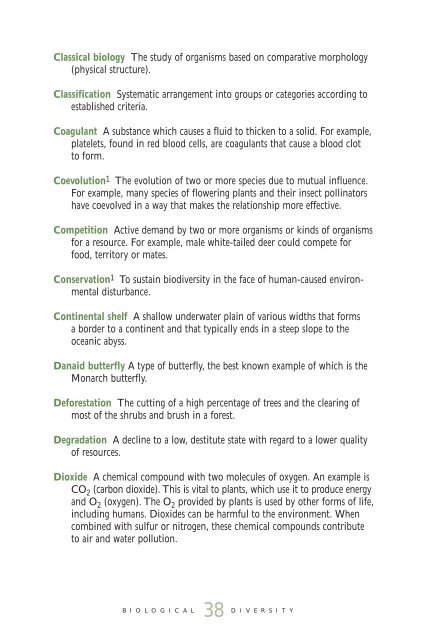Download Biological Diversity - New York State Museum
Download Biological Diversity - New York State Museum
Download Biological Diversity - New York State Museum
Create successful ePaper yourself
Turn your PDF publications into a flip-book with our unique Google optimized e-Paper software.
Classical biology The study of organisms based on comparative morphology<br />
(physical structure).<br />
Classification Systematic arrangement into groups or categories according to<br />
established criteria.<br />
Coagulant A substance which causes a fluid to thicken to a solid. For example,<br />
platelets, found in red blood cells, are coagulants that cause a blood clot<br />
to form.<br />
Coevolution 1 The evolution of two or more species due to mutual influence.<br />
For example, many species of flowering plants and their insect pollinators<br />
have coevolved in a way that makes the relationship more effective.<br />
Competition Active demand by two or more organisms or kinds of organisms<br />
for a resource. For example, male white-tailed deer could compete for<br />
food, territory or mates.<br />
Conservation 1 To sustain biodiversity in the face of human-caused environmental<br />
disturbance.<br />
Continental shelf A shallow underwater plain of various widths that forms<br />
a border to a continent and that typically ends in a steep slope to the<br />
oceanic abyss.<br />
Danaid butterfly A type of butterfly, the best known example of which is the<br />
Monarch butterfly.<br />
Deforestation The cutting of a high percentage of trees and the clearing of<br />
most of the shrubs and brush in a forest.<br />
Degradation A decline to a low, destitute state with regard to a lower quality<br />
of resources.<br />
Dioxide A chemical compound with two molecules of oxygen. An example is<br />
CO 2 (carbon dioxide). This is vital to plants, which use it to produce energy<br />
and O 2 (oxygen). The O 2 provided by plants is used by other forms of life,<br />
including humans. Dioxides can be harmful to the environment. When<br />
combined with sulfur or nitrogen, these chemical compounds contribute<br />
to air and water pollution.<br />
B i o l o g i c a l<br />
38 D i v e r s i t y
















